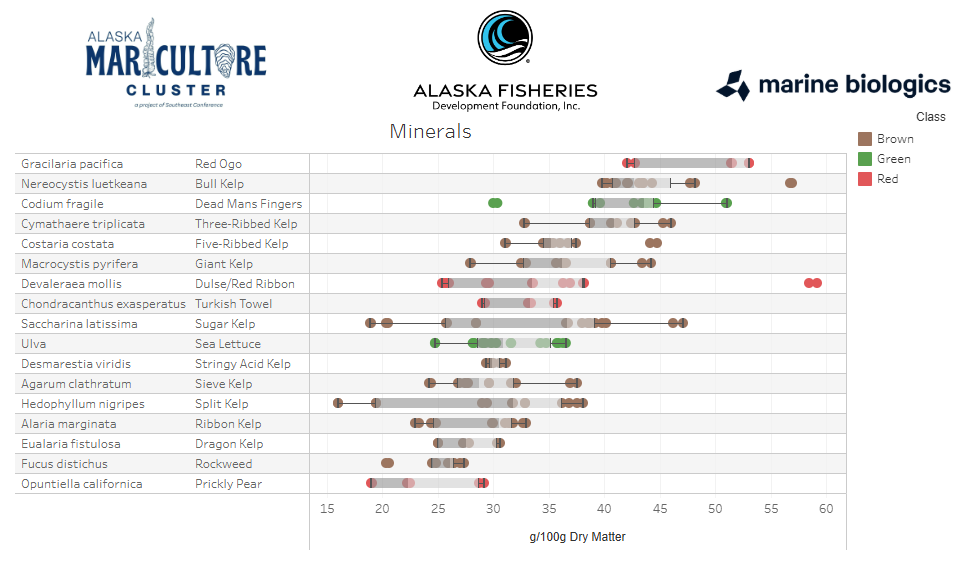Overview
Through the Alaska Fisheries Development Foundation (AFDF) subaward, the Alaska Mariculture Cluster (AMC) has funded three Research & Development projects focused on analyzing seaweed tissue composition to better understand the potential uses of Alaska’s kelps and other native seaweeds. These studies provide critical insights into nutritional content, valuable bioactive compounds, processing potential, and quality assurance. The Seaweed Tissue Analysis Program represents a major step toward commercializing and scaling Alaska’s seaweed industry. Led by AFDF, the program will collect and analyze samples from across Alaska to build a scientific foundation for product quality and marketability. In 2024, more than 100 samples across 15 species were analyzed by Celignis Limited, conducting 40 analyses per sample—including nutrients, carbohydrates, bioactives, vitamins, and trace elements. The results are now publicly available through an interactive Seaweed Tissue Analysis Dashboard.
To interpret and communicate these findings, Marine Biologics is developing species profiles and comparative analyses that highlight key differences among species, assess market opportunities, and recommend testing standards for future research. Together, these efforts are expected to:
- Support product innovation in food, nutraceuticals, biostimulants, bioplastics, and beauty
- Enable processors to refine extraction techniques for high-value compounds
- Inform future seaweed farming and harvesting strategies
- Establish industry standards for seaweed quality and composition
- Attract investment and market interest in Alaska’s mariculture sector
Click to jump to a project to learn more:
Phase One:
Celignis Limited: Laboratory Analysis of Samples from 15 Wild & Farmed Seaweed Species
Phase Two:
Marine Biologics: Consulting & Analysis of Seaweed Tissue Lab Data
Other Tissue Analysis Project:
University of Alaska Fairbanks: Carbohydrate Content in Alaska Kelps
Phase One:
Celignis Limited
Laboratory Analysis of Samples From 15 Wild & Farmed Seaweed Species
Funding: $360,000
Region: All Regions
Species: Agarum clathratum (sea colander); Alaria marginata (winged kelp); Chondracanthus exasperates (turkish towel); Codium fragile (dead man’s fingers); Costaria costata (five-ribbed kelp); Cymathaere triplicata (three-ribbed kelp); Desmarestia viridis (stringy acid kelp); Devaleraea mollis (dulse); Eualaria fistulosa (dragon kelp); Fucus distichus (rockweed); Gracilaria pacifica (red ogo); Hedophyllum nigripes (brown lacy kelp); Macrocystis pyrifera (giant kelp); Nereocystis luetkeana (bull kelp); Opuntiella californica (prickly pear); Saccharina latissima (sugar kelp); Ulva spp (sea lettuce).
This foundational study focused on analyzing the nutritional composition, carbohydrate content, and bioactive compounds in Alaskan seaweeds. Celignis conducted extensive testing on samples collected in Kodiak and Sitka in May and June 2024. Using advanced laboratory techniques, Celignis performed more than 40 different analyses per sample, assessing everything from basic macronutrients to specialized metabolites such as fucoidans, alginates, and phlorotannins.
This research is vital for identifying high-value compounds that could support Alaska’s food, agriculture, cosmetics, and biotechnology industries. Data from this project are analyzed under Project #2 to ensure translation into actionable insights for industry stakeholders.
Interim Update [Pending]
Final Report [Pending]
Phase Two:
Marine Biologics
Consulting & Analysis of Seaweed Tissue Lab Data
Funding: $45,000
Region: All regions
Species: Agarum clathratum (sea colander); Alaria marginata (winged kelp); Chondracanthus exasperates (turkish towel); Codium fragile (dead man’s fingers); Costaria costata (five-ribbed kelp); Cymathaere triplicata (three-ribbed kelp); Desmarestia viridis (stringy acid kelp); Devaleraea mollis (dulse); Eualaria fistulosa (dragon kelp); Fucus distichus (rockweed); Gracilaria pacifica (red ogo); Hedophyllum nigripes (brown lacy kelp); Macrocystis pyrifera (giant kelp); Nereocystis luetkeana (bull kelp); Opuntiella californica (prickly pear); Saccharina latissima (sugar kelp); Ulva spp (sea lettuce).
This ongoing project is designed to interpret and synthesize the vast amount of seaweed data produced through Celignis’s lab work (project above). Marine Biologics is producing species profiles, a comprehensive data set, and memos that surface key findings and recommendations. Their research will evaluate how nutritional, structural, and bioactive compounds vary by season, location, and species. Stakeholder interviews and market assessments will further refine the findings. By summarizing key findings in technical reports, species profiles, and industry benchmarks, this study will help farmers, processors, and policy makers make informed decisions about which species hold the most commercial promise. This work is expected to guide future seaweed tissue research, inform regulatory strategies, and further position Alaska as a leader in sustainable seaweed production.
Drawing on expertise in seaweed chemistry, data science, and market development, the Marine Biologics team developed this interactive dashboard to make the findings more accessible to farmers, processors, researchers, and policymakers. This dashboard enables users to explore chemical and functional profiles across species and to identify high-potential market applications and opportunities for Alaska’s growing seaweed industry.
University of Alaska Fairbanks
Carbohydrate Content in Alaska Kelps
Funding: $20,000
Region: Prince William Sound
Species: Bull kelp, ribbon kelp, sugar kelp
A separate project from the two described above, this study – a master’s thesis project by a University of Alaska Fairbanks student – examined polysaccharides concentrations in farmed kelp in Alaska. These carbohydrates are a focus of several seaweed processing startup companies, with applications in health supplements, medicine, and other markets. This study assessed the relative abundance of four carbohydrates (glucan, mannitol, alginate, and fucoidan) in bull, ribbon, and sugar kelp. AMC funds supported purchases of cultivated kelp, sampling supplies, and lab services. Cameron Jardell, lead researcher at UAF, continues to be involved in development of Alaska mariculture industry and currently works on kelp gametophyte seeding research at the Chugach Regional Resources Commission in Seward.
Interim Update [Pending]
Final Report [Pending]
Seaweed Tissue Analysis Program News
Read more about the Seaweed Tissue Analysis Program below:


